The aviation industry faces a pivotal moment as SAF enters rapid expansion, with rising demand and tightening mandates driving up prices, making now the ideal time for airlines and corporate buyers to secure affordable deals.


Unlock the full potential of sustainable aviation fuels
How airlines can reduce environmental impact while maintaining economic viability
Aviation is at a pivotal moment in its sustainability journey. Sustainable Aviation Fuel (SAF) has emerged as a cornerstone of decarbonization efforts, yet, despite its promise, SAF adoption faces a significant hurdle: its cost. With SAF prices typically two to three times higher than traditional jet fuel, airlines are grappling with the dual challenge of reducing their environmental impact while maintaining economic viability.
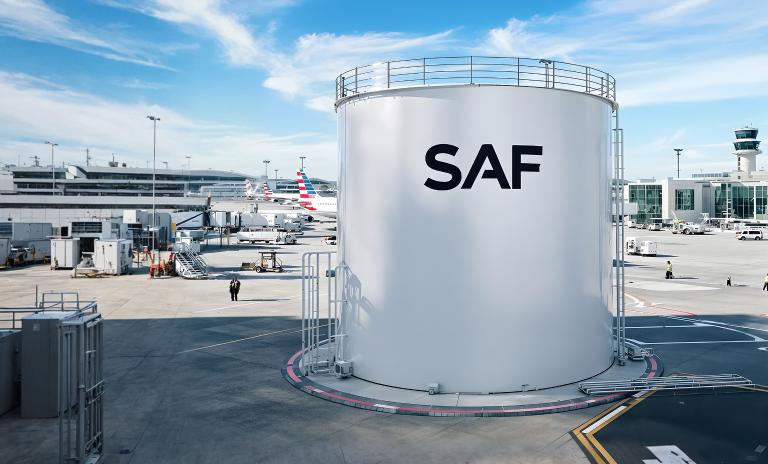
To overcome these obstacles and unlock the full potential of SAF, airlines can embrace innovative procurement strategies and tailored monetization approaches. By doing so, they can not only meet ambitious sustainability targets but also gain a competitive edge in the evolving aviation landscape.
The high stakes of SAF adoption
SAF offers unparalleled environmental benefits, significantly reducing greenhouse gas emissions compared to conventional jet fuel. However, its high production costs present a major barrier to widespread adoption. Today, many airlines pass these costs on to customers, and while the initial impact on customer willingness to pay (WTP) may be minimal, this dynamic is likely to shift.
As regulatory mandates for SAF increase and airlines voluntarily adopt higher levels of SAF to meet decarbonization targets, the financial strain could grow. This may ultimately affect airline profitability and competitiveness, making it imperative for airlines to develop robust strategies to mitigate costs and maximize returns.
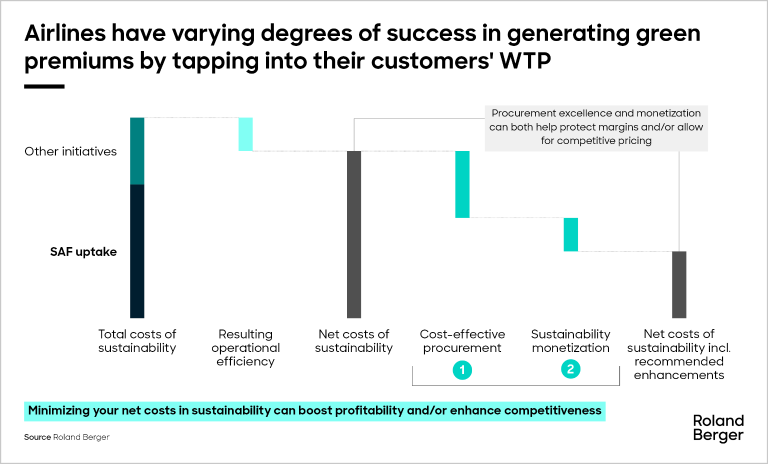
Procurement excellence: Securing SAF at competitive costs
To address the cost challenges of SAF, airlines must adopt innovative procurement strategies that go beyond traditional approaches. By securing SAF at below-market prices, airlines can reduce financial strain while still increasing SAF uptake, thereby continuing to drive a strong demand signal and driving the construction of new production facilities.
Key strategies can include:
- Signing major offtake agreements: Airlines can secure long-term supply by committing to large or first major offtake agreements, providing SAF producers with the financial security needed to scale production. It is also essential to define a price corridor that can be protected using options and puts to help manage price volatility in the evolving market.
- Risk mitigation for producers: By sharing production risks contractually, airlines can negotiate lower SAF prices while fostering stronger partnerships with suppliers.
- Forming buying consortia: Airlines can enhance their negotiating power by joining forces with other buyers to purchase SAF collectively.
- Leveraging global networks: Airlines can tap into international markets with lower SAF costs through their global networks and book-and-claim systems.
- Financing production expansion: Investing in SAF production facilities or increasing the kerosene fraction for existing facilities can help airlines secure supply at favorable rates.
- Equity infusions: By taking equity stakes in SAF facilities, airlines can negotiate even better cost-plus agreements, ensuring predictable pricing over time.
In addition to these strategies, airlines operating in the U.S. can leverage federal subsidies under the Inflation Reduction Act (IRA) and Direct Air Capture (DAC) initiatives, as well as state-level incentives, to further reduce costs.
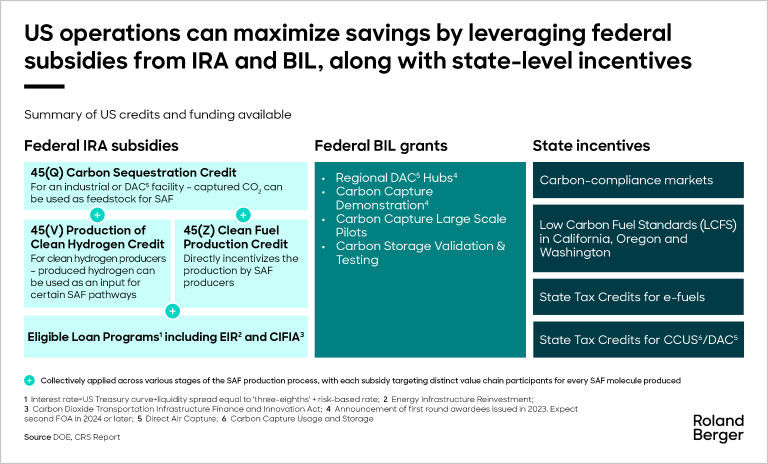
"To unlock SAF's full potential as a strategic differentiation lever, airlines must combine innovative procurement strategies with tailored monetization approaches, meeting sustainability targets and gaining a competitive edge."
Together, these mechanisms empower airlines to obtain SAF at economically viable prices, while instilling the confidence and risk-sharing needed to drive production growth and facilitate the opening of new facilities.
Monetization strategies: Turning sustainability into a revenue opportunity
Procurement alone is not enough to unlock the full potential of SAF. Airlines must also focus on monetizing sustainability by aligning their offerings with the unique motivations and WTP of different customer segments. This involves creating tailored solutions for:
Cargo customers: These customers are typically businesses with their own public sustainability targets, often taking on the roadmap outlined by the Science Based Targets initiative (SBTi). Given that the net cost of SAF is relatively low compared to the value of the transported products – especially since air cargo is often used for high value density goods - even using 100% SAF can be quite affordable. For example, considering typical values for goods transported by air, we estimate that 100% SAF uptake can be achieved with a
- ~0.5% price increase for a laptop,
- ~1% price increase for an item of clothing, or
- ~2% price increase for a bouquet of flowers
- etc.
However, passing on the cost is insufficient: operators must effectively communicate this advantage to unlock demand. Airlines can implement strategies ranging from three-way agreements where they are compensated for SAF purchases through handling fees to full WTP approaches that include green offerings tailored to meet the specific needs of cargo customers (see “De-risking to generate value throughout the SAF supply chain” below for more details).
Corporate clients: Similar to cargo customers, corporate clients often have publicly announced sustainability targets, frequently with ambitious commitments for 2030-2040. In many industries – such as banking, professional services, legal, etc – flying can often represent a significant share of companies’ total emissions, meaning that any near-term meaningful action requires aviation decarbonization, generally through SAF. Roland Berger is itself a case-in-point as flying represents ~60% of our total annual CO2 emissions: to meet our ambitious SBTi targets, we follow a two-pronged approach: avoid air travel where possible, and abate remaining flight emissions through SAF procurement. By rethinking offer management, airlines can align with these customers’ decarbonization goals, creating compelling narratives that appeal to their sustainability objectives.
Leisure customers: Recent findings indicate that customers exhibit a notable willingness to pay when prompted; however, the conversion rates remain relatively low. This trend can be partially attributed to the absence of compelling offers that resonate with customers' perceptions of value. Through our comprehensive research, we have developed significant expertise in understanding what customers truly regard as valuable within the framework of sustainability. We are well-positioned to assist airlines in harnessing this knowledge to create customer-value-driven offerings, which can enhance customer satisfaction while mitigating the impact of regulatory challenges in the market.
Importantly, this approach does not solely apply to SAF, it also encompasses other sustainable goods and services as long as real action is being taken and can be proven accordingly.
De-risking to generate value throughout the SAF supply chain
Combining together procurement and monetization strategies is key: by aligning characteristics of SAF procured with SAF certificates sold (e.g., in carbon intensity, pathways/feedstocks, volumes, costing/pricing, contract duration and terms, logistical considerations, etc), airlines can align incentives and expectations through the SAF supply chain. There is indeed a continuum of structures for agreements that is possible here in the B2B space (with cargo and corporate customers):
- From unlinked (not de-risked) deals,
- to “back-to-back” deals where airlines contract separately but in close alignment with SAF suppliers and B2B customers,
- to 3-way agreements involving the SAF supplier, airline and B2B customer,
- to full special purpose vehicles dedicated to risk management, with equity investments from all parties involved.
Act now: A new era of sustainable aviation
The SAF market is at a critical inflection point. Regulatory mandates are tightening, voluntary adoption is accelerating, and global demand is rising. For airlines, the message is clear: the time to act is now. By securing long-term offtake agreements and investing in innovative procurement and monetization strategies, airlines can lock in competitive SAF deals before prices surge.
Integrating cost-minimization and revenue-maximization strategies can help airlines to achieve their sustainability goals without compromising profitability. By taking a proactive approach to SAF procurement and monetization, airlines can transform sustainability from a challenge into a competitive advantage.
At Roland Berger, we are committed to supporting airlines in this transformative journey. Contact us today to learn more about our SAF solutions and schedule a complimentary workshop to help you achieve your sustainability goals.
We would like to thank Mona Benzekri for her contribution to this article.
Register now to receive regular insights into our Transportation, Tourism and Logistics topics.


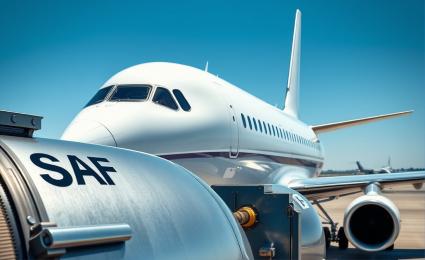

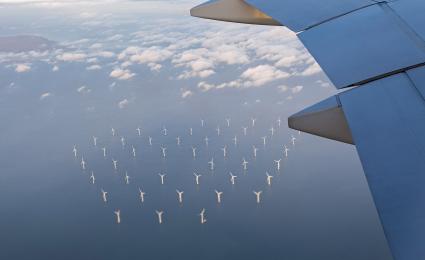
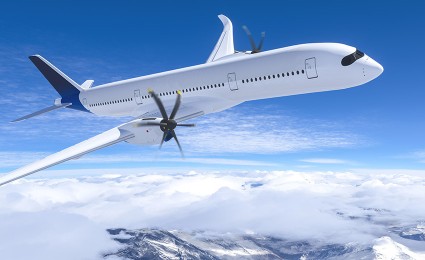






_person_320.png?v=770441)